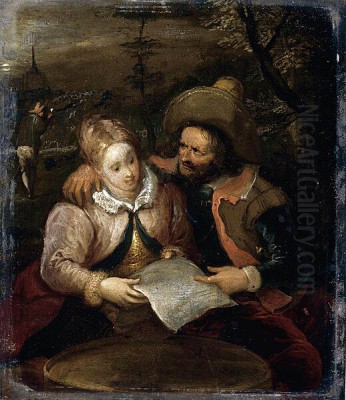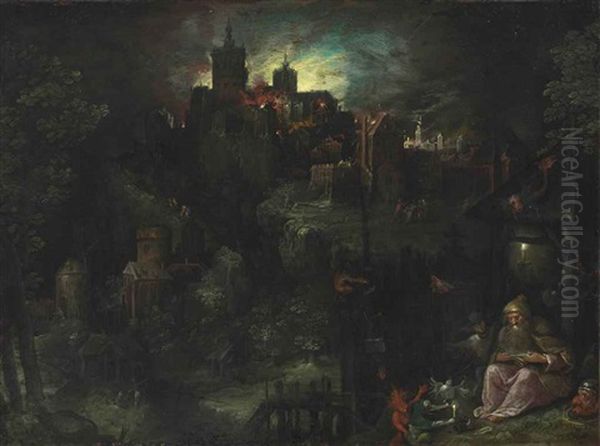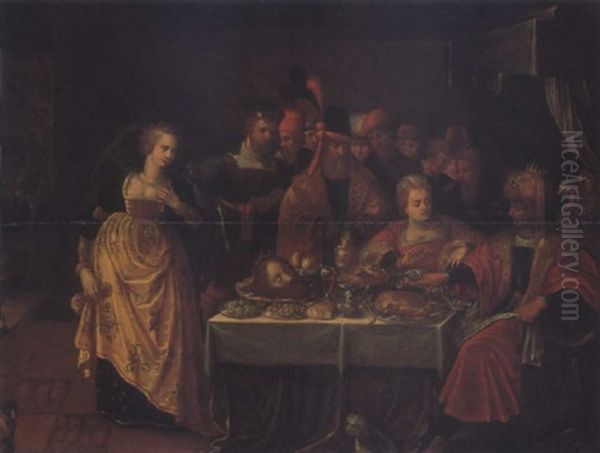
Frans Francken III (1607–1667) stands as a significant figure within the prolific Francken dynasty of painters, a family whose artistic endeavors shaped the visual culture of Antwerp throughout the 16th and 17th centuries. Born into this artistic lineage, Frans III inherited not only a name but also a rich tradition of craftsmanship and thematic exploration. He navigated the vibrant Antwerp art scene, contributing his own distinct vision while upholding the family's reputation for detailed and engaging works, primarily in the popular format of cabinet pictures. His life and career reflect the collaborative spirit and specialized production methods characteristic of the Flemish Baroque era.
As an artist active during a period of immense artistic production and innovation in the Southern Netherlands, Frans Francken III carved out a niche for himself. He specialized in small-scale, finely executed paintings depicting religious, mythological, and allegorical subjects, often infused with intricate details and lively narratives. His work, while deeply rooted in the style established by his father, also demonstrates subtle shifts and contributions, particularly in the handling of figures and the popularization of specific genres like the kunstkammer or 'art collection gallery' painting. Understanding his contributions requires looking at his family background, his training, his stylistic choices, his collaborations, and his lasting influence.
The Francken Dynasty: A Foundation in Art
The Francken family was a veritable artistic powerhouse in Antwerp for multiple generations. The dynasty's founder is generally considered to be Nicolaes Francken, but its most prominent artistic line began with Frans Francken I (c. 1542–1616), known as 'the Elder'. Frans the Elder established a successful workshop and gained recognition for his historical and religious paintings, becoming a dean of the Antwerp Guild of Saint Luke. His success laid the groundwork for his sons, who continued and expanded the family's artistic enterprise.

Frans the Elder had several sons who became painters, most notably Hieronymus Francken I (c. 1540–1610), who primarily worked in France, Ambrosius Francken I (1544–1618), and Frans Francken II (1581–1642), known as 'the Younger'. It was Frans Francken II who became the most famous and prolific member of the family, running a large and highly productive workshop. He specialized in small and medium-sized cabinet pictures filled with figures, popularizing new themes like kunstkammer paintings and scenes featuring monkeys in human attire (singeries). His style, characterized by elegant figures, vibrant colors, and detailed settings, profoundly influenced his sons, including Frans Francken III.
Frans Francken II married Elisabeth Placquet, and together they had a large family. Several of their sons followed in their father's footsteps, becoming painters themselves. This included Frans Francken III, the eldest son, as well as Hieronymus Francken III (1611–1671) and Ambrosius Francken III (1614–1662). This dense network of familial artistic activity meant that training often occurred within the family workshop, styles were shared and adapted, and collaborations were frequent. Frans III grew up immersed in this environment, learning the craft directly from his highly successful father.
Early Life and Training
Frans Francken III was baptized in Antwerp on 6 May 1607. As the eldest son of the renowned Frans Francken II, his path towards an artistic career was almost predetermined. He received his initial training within his father's bustling workshop, absorbing the techniques, stylistic conventions, and popular subject matter that had brought the family considerable success. This apprenticeship involved learning the fundamentals of drawing, composition, and painting, likely starting with grinding pigments and preparing panels before moving on to copying works and eventually contributing to workshop productions.
The influence of Frans Francken II on his son's early work is undeniable. Frans III adopted his father's preference for small-scale, detailed cabinet pictures and tackled similar themes drawn from the Bible, mythology, and allegory. He learned the characteristic Francken style of depicting elegant, somewhat elongated figures, often arranged in dynamic, populated scenes. The meticulous attention to detail in fabrics, objects, and settings, a hallmark of his father's work, also became a feature of Frans III's own paintings.
Distinguishing the early works of Frans III from those of his father or even his brothers can sometimes be challenging, given the collaborative nature of the workshop and the shared stylistic vocabulary. However, over time, Frans III developed his own subtle variations. Some art historians note a slightly looser brushwork or different figural types compared to his father, but he largely remained faithful to the established Francken brand. His training provided him with a solid technical foundation and a deep understanding of the market demands for cabinet paintings in Antwerp.
Entry into the Antwerp Guild and Professional Career

Following his training within the family workshop, Frans Francken III established himself as an independent master. A key step in this process was joining the prestigious Antwerp Guild of Saint Luke, the professional organization for painters, sculptors, and other artisans. Records indicate that he was registered as a wijnmeester (master by descent, son of a master) in the Guild for the guild year 1639–1640. This official recognition marked his full entry into the professional art world of Antwerp, allowing him to take on his own commissions and apprentices.
His standing within the artistic community grew over the years. His skill and adherence to the popular Francken style ensured a steady demand for his work. He continued to produce the cabinet paintings favored by collectors, depicting a wide range of subjects that appealed to the tastes of the Antwerp bourgeoisie and aristocracy. His involvement in the Guild culminated in his appointment as deacon (deken) for the guild year 1656–1657. Holding this position was a significant honor, reflecting the respect he commanded among his peers and his established position within the city's artistic hierarchy.
Throughout his career, Frans III maintained the family workshop, likely collaborating frequently with his brothers Hieronymus III and Ambrosius III. The workshop continued to produce paintings in the recognizable Francken style, catering to both local and international markets. While perhaps not achieving the same level of fame or prolific output as his father, Frans III was a respected and successful artist in his own right, contributing significantly to the continuation of the Francken artistic legacy into the mid-17th century.
Artistic Style and Characteristics
Frans Francken III's art is firmly rooted in the Flemish Baroque tradition, specifically the Antwerp school's specialization in cabinet painting. His style is characterized by a preference for small formats, typically painted on copper or wood panels, which allowed for intricate detail and a jewel-like finish. This scale was well-suited for private collectors who displayed these works in their homes, often in dedicated cabinets or small galleries.
His brushwork is generally fine and meticulous, particularly in rendering details of clothing, architecture, and decorative objects. While inheriting the elegance of his father's figures, Frans III's handling can sometimes appear slightly more robust or less idealized than that of Frans II. His color palette often features rich, saturated hues, contributing to the vibrancy of his narrative scenes. He excelled at composing complex scenes with numerous figures, skillfully arranging them to tell a story or illustrate an allegory.

Compared to the grand scale and dramatic intensity of contemporaries like Peter Paul Rubens or Anthony van Dyck, Francken III's work offers a more intimate and detailed viewing experience. His focus was less on overwhelming emotion and more on narrative clarity, intricate detail, and often, a degree of intellectual or moral content, especially in his allegorical and kunstkammer paintings. He mastered the art of packing complex narratives and symbolic elements into relatively small spaces, inviting close inspection from the viewer.
Subject Matter: Religion, Myth, and Allegory
Like his father and uncles, Frans Francken III drew heavily upon traditional subject matter favored by the Antwerp market. Religious themes formed a significant part of his output. He depicted numerous scenes from both the Old and New Testaments, often choosing moments rich in narrative potential or dramatic action. Examples include The Destruction of Sodom and Gomorrah, showcasing his ability to handle crowded, chaotic scenes, and more contemplative subjects like the Lamentation of Christ, where he focused on conveying pathos and piety.
Mythological subjects, drawn from classical antiquity, were also popular. These allowed for the depiction of heroic figures, dramatic encounters, and often, the nude form. A known example attributed to his circle is The Rape of the Sabine Women, a dynamic composition filled with struggling figures that demonstrates the Francken workshop's skill in rendering movement and emotion within a historical narrative framework.
Allegorical paintings, conveying moral or philosophical messages through symbolic imagery, were another Francken specialty continued by Frans III. Works like Man Choosing between Virtue and Vice or allegories of the senses, sciences, or even contemporary events like Allegory of Tulipomania (often attributed to Jan Brueghel the Younger but stylistically related to Francken works), catered to a sophisticated audience interested in intellectual themes. These paintings often featured complex iconography that viewers were expected to decipher, adding an intellectual dimension to the visual pleasure.
Innovations: Kunstkamers and Singeries
While working within established traditions, Frans Francken III also contributed to the popularity of specific, innovative genres closely associated with his family, particularly the kunstkammer or 'art collection gallery' painting. Pioneered by artists like Jan Brueghel the Elder and Frans Francken II, these paintings depict idealized interior spaces filled with paintings, sculptures, scientific instruments, natural specimens (shells, flowers), and other collectibles. Frans III continued this tradition, creating intricate scenes that celebrated art, science, and the passion for collecting prevalent among Europe's elite.
These kunstkammer paintings were more than mere inventories; they were often complex allegories of knowledge, taste, or worldliness. They showcased the artist's skill in rendering diverse objects and textures in miniature and reflected the encyclopedic interests of the era. Frans III's contributions to this genre helped solidify its popularity, influencing other artists like David Teniers the Younger, who also produced numerous gallery paintings.
Another genre associated with the Francken workshop, though perhaps more strongly with Frans II, is the singerie, or 'monkey scene'. These satirical paintings depict monkeys dressed in human clothes, engaging in human activities like feasting, playing cards, or even painting. While Frans III's involvement in singeries might be less pronounced than his father's, the genre represents the playful and sometimes satirical side of Flemish art during this period, and it remained part of the broader Francken workshop repertoire.
A Master Collaborator
Collaboration was a cornerstone of art production in 17th-century Antwerp, and Frans Francken III was deeply involved in this practice. The sheer volume of work produced often necessitated specialization, with different artists contributing elements according to their expertise. Frans III frequently collaborated with other masters, most notably architectural painters. His skill in depicting small, lively figures made him an ideal partner for artists who specialized in rendering detailed church interiors or cityscapes but were less adept at populating them.
His most well-documented collaboration was with Pieter Neeffs the Elder (and later his son, Pieter Neeffs the Younger), specialists in depicting church interiors. In numerous paintings, Neeffs would meticulously render the Gothic architecture of Antwerp Cathedral or other imaginary churches, while Francken III would add the 'staffage' – the figures of priests, worshippers, and visitors that brought the scenes to life. Examples of this successful partnership, such as Interior of a Gothic Church or Interior of Antwerp Cathedral, can be found in major museums like the Royal Museum of Fine Arts Antwerp, the Louvre in Paris, and the Thyssen-Bornemisza Museum in Madrid.
Beyond the Neeffs family, Frans III likely collaborated with other artists as well. It was common practice for figure specialists like him to add staffage to landscapes painted by artists such as Joos de Momper or Kerstiaen de Keuninck, or to still lifes created by masters like Jan van Kessel the Elder. He also worked closely with his own family members, particularly his brothers Hieronymus III and Ambrosius III. This collaborative network was essential to the efficiency and versatility of the Antwerp art market. Other contemporaries he might have interacted with or whose work circulated in the same circles include Sebastiaen Vrancx and Gonzales Coques.
The Francken Workshop and Legacy
Frans Francken III inherited and maintained the family workshop, a crucial element in the production and dissemination of the Francken style. Like his father's, his workshop likely employed assistants and apprentices who helped with various stages of painting production, from preparing panels to painting backgrounds or less critical areas. This system allowed for a relatively high output of works that adhered to the recognizable family brand, ensuring commercial viability.
The workshop served as a training ground for the next generation. While Frans III's direct influence might not have spawned major independent masters outside the family, he did pass on his skills within the Francken lineage. His own son, Constantijn Francken (1661–1717), also became a painter, continuing the family tradition into the early 18th century, although the dynasty's prominence gradually waned after Frans III's generation.
The legacy of Frans Francken III lies in his role as a skilled practitioner and carrier of the Francken tradition. He successfully adapted his father's style and themes for the mid-17th-century market, excelling in the creation of detailed, narrative-rich cabinet pictures. His contributions to specific genres like the kunstkammer painting and his numerous collaborations, especially with architectural painters, solidified his place within the complex network of Antwerp artists. He represents the continuity and specialization that characterized much of Flemish Baroque art production.
Influence on Later Art
While perhaps not as revolutionary as figures like Rubens or Rembrandt, Frans Francken III's work and the broader Francken style did exert influence. The sheer number of cabinet pictures produced by the family workshop helped popularize this format and its associated themes throughout Flanders and beyond. The detailed, narrative style found favor with collectors across Europe.
His kunstkammer paintings, along with those of his father and Jan Brueghel the Elder and Younger, significantly influenced later depictions of galleries and collections, most notably by David Teniers the Younger, who became famous for his portrayals of Archduke Leopold Wilhelm's art collection. The meticulous rendering of interiors and objects in Francken's work may also be seen as part of the broader Flemish tradition that valued detailed realism, a tradition that arguably informed later developments in Dutch genre painting, although direct influence on artists like Johannes Vermeer is speculative and likely indirect at best.
More directly, the Francken style, perpetuated through the workshop and collaborations, contributed to the visual language of Antwerp painting in the mid-17th century. Artists specializing in small-scale figure painting continued to draw on the models and compositional types established by the Francken dynasty. His work remains a testament to the high level of craftsmanship and the diverse thematic interests of the Flemish Baroque.
Major Collections
Today, works by Frans Francken III and his workshop can be found in numerous prestigious museums and collections around the world, attesting to his historical significance and the enduring appeal of his art. Key institutions holding his paintings include:
The Royal Museums of Fine Arts of Belgium in Brussels
The Royal Museum of Fine Arts Antwerp
The Louvre Museum in Paris
The Thyssen-Bornemisza National Museum in Madrid
The Kunsthistorisches Museum in Vienna
The Lithuanian National Museum of Art in Vilnius
The Rijksmuseum in Amsterdam
Various regional museums in Belgium, the Netherlands, France, and Germany, as well as private collections.
These collections preserve important examples of his religious scenes, mythological subjects, allegories, and collaborations, particularly the church interiors painted with Pieter Neeffs the Elder. Studying these works allows for a deeper appreciation of his skill and his place within the rich tapestry of 17th-century Flemish art.
Conclusion
Frans Francken III was a talented and productive member of one of Antwerp's most important artistic dynasties. Working in the shadow of his highly successful father, Frans II, he nevertheless carved out his own respected career, upholding the family's reputation for high-quality cabinet paintings. He excelled in depicting detailed narrative scenes drawn from religion, mythology, and allegory, and played a significant role in popularizing the kunstkammer genre.
His numerous collaborations, especially with architectural specialists like Pieter Neeffs the Elder, highlight the interconnected and specialized nature of the Antwerp art market. While adhering closely to the established Francken style, his work demonstrates consistent skill and craftsmanship. As a master in the Guild of Saint Luke and later its deacon, he was a recognized figure in the city's artistic life. Frans Francken III's legacy endures through his paintings, which offer a window into the tastes, beliefs, and artistic practices of the Flemish Baroque era, preserved in collections worldwide. He remains a key figure for understanding the depth and diversity of painting in 17th-century Antwerp beyond the monumental works of its most famous masters.